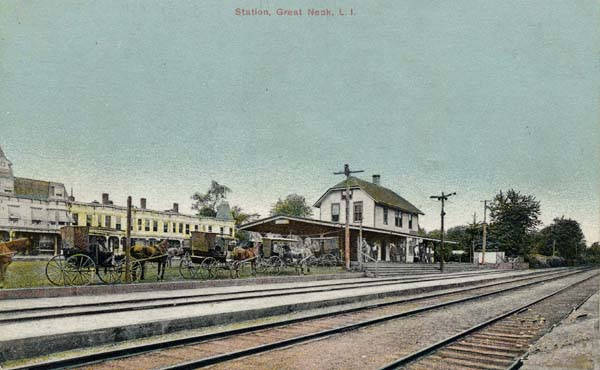Long before the roar of trains, travelers bound for Long Island’s North Shore relied on sidewheel steamboats to reach places like Great Neck. In the early 19th century, steamboats evolved from Robert Fulton’s pioneering Clermont (1807) and by the late 1820s were calling regularly at North Shore landings. The Linnaeus, captained by Elijah Peck, began daily service in 1829 from Glen Cove–then called Garvies Point–stopping at Whitestone and other towns before docking at Manhattan’s Fulton Market slip.
These vessels revolutionized travel between Manhattan and Long Island. Previously, sloops–slow, weather‑dependent sailboats–had circled the Long Island Sound. Steamboats offered far greater reliability and speed, quickly sparking a boom in resort development, estate building and cultural activity on the North Shore.
At its peak, more than 40 steamboats plied the route to North Shore villages–including Great Neck—with famed vessels like the George Law, Idlewild and Sagamore ferrying wealthy Manhattanites to summer estates, oyster houses and hotels. The Sagamore remained in service until 1916.
A Town’s Transformation
Steamboat access turned once‑quiet coastal hamlets into thriving suburban retreats. Mail, freight and passengers flowed in and out daily. Civic institutions grew; hotels and taverns sprang to life; and estates along the Sound became weekend havens for families like the Morgans, Guggenheims and Woolworths.
While steamboat traffic continued into the late 19th century (Idlewild ran perhaps as late as 1908), railroads steadily gained dominance.
Iron Rails: The Coming of the Railroad
Great Neck Station Opens

Rail reached Great Neck in October 1866 when the Flushing and North Side Railroad extended its line from Flushing through to Great Neck. First trial trains ran Aug. 31; full public service began Oct. 27, 1866, with a single daily round‑trip between Great Neck and Hunter’s Point in Long Island City.
Early schedules featured limited service–one morning departure and one return trip–but expanded by 1867 to two daily rounds. Telegraph lines and railway post office services were soon instituted, facilitating daily mail and passenger use.
Integration into LIRR
The Flushing and North Side, along with competing lines, merged into the Flushing, North Shore & Central Railroad by 1874, quickly absorbed by the Long Island Rail Road, giving travelers continuous rail access from Manhattan across Queens to Great Neck.
Great Neck became the railhead of this North Shore network. Early station amenities were modest, but new depots were built (including one in 1883) as the area urbanized.
Rise of the Railroad
Even before the Brooklyn Bridge opened in 1883, rail travel was steadily eclipsing steamboats. Though bridge completion facilitated regional transit, the steamboat era had already peaked. LIRR extensions to Glen Cove (1867), Oyster Bay (1865-1869) and eventually Port Washington (1898) further diminished boat travel.
By 1898, Great Neck was a key junction and the North Shore railway network linked seamlessly to Port Washington, crossing the marshes via the Manhasset Viaduct. Trains crossed into Long Island City, with ferries serving Manhattan–rail‑ferry transfers that persisted well into the early 20th century.
Impact on Great Neck
The introduction of rail service sparked suburban growth. By the early 1900s, Great Neck evolved into a commuter community. Farms were parceled; estates and workers’ housing rose around the station by 1910. Shoppers, commuters and postal traffic shifted away from steamboat docks, centering instead around the bustling rail depot.
This commuter transformation would frame Great Neck’s identity long before artists and writers like F. Scott Fitzgerald dubbed the area “West Egg.” Its social and cultural foundations were anchored in both waterborne access and rail connectivity.
In the century before the Brooklyn Bridge’s completion, Great Neck’s access to Manhattan evolved dramatically. The steamboat era, launched by vessels like the Linnaeus in 1829, inaugurated dependable links between the North Shore and New York City, fueling cultural, economic and residential growth. From the 1830s up to the early 1860s, these boats were the region’s lifeline.
Yet by 1866, rails had arrived. The railroad’s ascendancy–bolstered by mergers, extensions and infrastructure like telegraph, mail and ferry connections–transformed Great Neck into a suburban rail hub. By the late 19th century, steamboats had dwindled, eclipsed by faster, more reliable train travel.
Today, Great Neck’s story resides in its historic station (rebuilt above-ground in 1925, later depressed in 1934), its shift from waterfront landings to commuter rail and its evolution into a town shaped by iron rails rather than steam paddles.


































